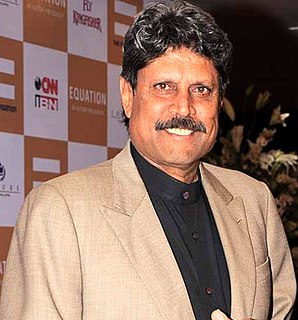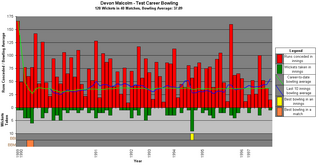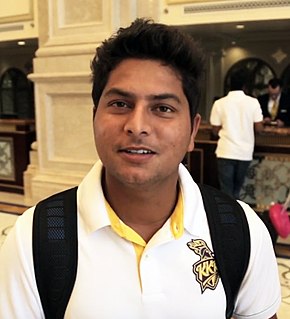Related Research Articles

Kapil Dev Ramlal Nikhanj is an Indian former cricketer. He was a fast-medium bowler and a hard-hitting middle-order batsman, and was named by Wisden as the Indian Cricketer of the Century in 2002.

Andrew Richard Caddick is a former cricketer who played for England as a fast bowler in Tests and ODIs. At 6 ft 5in, Caddick was a successful bowler for England for a decade, taking 13 five-wicket hauls in Test matches. He spent his entire English domestic first-class cricket career at Somerset County Cricket Club, and then played one Minor Counties match for Wiltshire in 2009.

Stuart Charles Glyndwr MacGill is an Australian former cricketer who played 44 Test matches and three One Day Internationals for the Australian national cricket team. He is a right-arm leg spin bowler, who has been credited with having the best strike rate of any modern leg-spin bowler, but he did not have a regular place in the Australian Test team due to the dominance of Shane Warne in the position of sole spinner. His bowling was slightly slower through the air than Warne's, but he was a prodigious turner of the ball.

Devon Eugene Malcolm is a former English cricketer. Born in Kingston, Jamaica, Malcolm played in 40 Test matches and 30 One Day Internationals for the England cricket team.
John Ernest Emburey is a former English first-class cricketer who played for Middlesex, Northamptonshire, Western Province, Berkshire and England.
Raymond Illingworth CBE was an English cricketer, cricket commentator and administrator. As of 2015, he was one of only nine players to have taken 2,000 wickets and made 20,000 runs in first-class cricket. He played for Yorkshire, Leicestershire (1969–1978) and England (1958–1973) and was a Wisden Cricketer of the Year in 1960.

Richard Keith Illingworth is an English former cricketer, who is currently an umpire. The bulk of his domestic cricketing career occurred with Worcestershire, although he had a spell with Derbyshire, and overseas with Natal. He played in nine Tests and twenty five ODIs for England, including participating in the 1992 and 1996 Cricket World Cups. Several websites, mistakenly, report that he is Ray Illingworth's son but the two are not related.
Victor James Marks is an English sports journalist and former professional cricketer.
The England cricket team toured Australia during the 1986–87 cricket season for a five-match Test series to contest The Ashes. While in Australia, England also played a number of tour matches against state and representative teams, and competed in two One-Day International (ODI) tournaments. Under the captaincy of Mike Gatting, England retained the Ashes with a 2–1 series win.
Bruce Yardley was an Australian cricketer who played in 33 Test matches and seven One Day Internationals between 1978 and 1983, taking 126 Test wickets.

Peter Mark Such is an English cricketer, cricket coach, and match referee. An off-spinner, Such was brought into the Test arena in 1993 as a replacement for John Emburey but, despite taking 6 for 67 on debut and being the highest wicket taker for England in the series only played an initial eight Tests before having to wait 5 years before his next appearance.

Graeme Peter Swann is an English former cricketer who played all three formats of the game. Born in Northampton, he attended Sponne School in Towcester, Northamptonshire. He was primarily a right-arm off-spinner, and also a capable late-order batsman with four first-class centuries, and often fielded at second slip. Swann could score quickly; his test strike rate is the highest of any male English batter to have scored at least 1000 runs.

Philippe-Henri Edmonds is a former cricketer who represented England at international level and Middlesex at county level. After retiring he became a successful, albeit controversial, corporate executive.
Geoffrey Miller, is an English former cricketer, who played in 34 Test matches and 25 One Day Internationals for the England cricket team between 1976 and 1984. He played for Derbyshire from 1973 to 1986, captaining the side from 1979 to 1981, and returned in 1990 after playing for Essex between 1987 and 1989. He was an England selector from 2008 to 2013 and was appointed President of Derbyshire C.C.C. in March 2014.
Ray Illingworth captained the English cricket team in Australia in 1970–71, playing as England in the 1970-71 Ashes series against the Australians and as the MCC in their other matches on the tour. They had a successful tour, but an acrimonious one as Illingworth's team often argued with their own management and the Australian umpires. When they arrived the Australian selector Neil Harvey called them "rubbish", and others labelled them "Dad's Army" because of the seniority of the players, whose average age was over 30, but these experienced veterans beat the younger Australian team. They are the only touring team to play a full Test series in Australia without defeat.
The West Indian cricket team played 16 first-class cricket matches in England in 1988, under the captaincy of Viv Richards. They enjoyed considerable success during the tour, while England endured a "disastrous summer" of continuous change.

Kuldeep Yadav is an Indian international cricketer who plays for India and for Uttar Pradesh in domestic cricket. He was signed by the Delhi Capitals for the 2022 Indian Premier League. He has played for the India Under-19 cricket team. On 18 December 2019, against the West Indies, he became the first bowler for India to take two hat-tricks in international cricket. On 17 January 2020, in the second ODI against Australia, Yadav became the fastest spin bowler for India, in terms of innings, to take 100 wickets in ODI cricket, in his 58th innings.
References
- ↑ Bateman, Colin (1993). If The Cap Fits. Tony Williams Publications. p. 88. ISBN 1-869833-21-X.
- ↑ "Full Scorecard of Australia vs England 5th Test 1982/83". ESPNcricinfo. Retrieved 4 July 2021.
- ↑ "Animal antics". ESPNcricinfo. Retrieved 4 July 2021.
- ↑ "Derbyshire v Nottinghamshire at Derby". ESPNCricinfo . Retrieved 13 May 2022.
- ↑ "Full Scorecard of England vs West Indies". ESPNcricinfo.
- ↑ "Full Scorecard of England vs India 2nd SF 1987/88 – Score Report | ESPNcricinfo.com". ESPNcricinfo. Retrieved 4 July 2021.
- ↑ "Reliance World Cup Final". ESPNcricinfo. Retrieved 4 July 2021.
- ↑ "Full Scorecard of England vs Australia". ESPNcricinfo. Retrieved 4 July 2021.
- ↑ "Fury in Faislabad". ESPNcricinfo. Retrieved 4 July 2021.
- ↑ "Nottinghamshire v Yorkshire at Worksop 21-23 July". ESPNCricinfo . Retrieved 13 May 2022.
- ↑ "Full Scorecard of Australia vs England 5th test 1989". ESPNcricinfo. Retrieved 4 July 2021.
- ↑ "Full scorecard of England v New Zealand 3rd Test 1990". ESPNCricinfo . Retrieved 13 May 2022.
- ↑ "Records/List A matches/Bowling/Most wickets in career". ESPNcricinfo. Retrieved 4 July 2021.
- ↑ "Sussex v West Indians at Brighton, 1-3 July 1995". ESPNCricinfo . Retrieved 22 July 2022.
- ↑ Frindall, Bill (1998). The Wisden Book of Cricket Records (Fourth ed.). London: Headline Book Publishing. p. 242. ISBN 0747222037.
- ↑ "Where are they now?". 31 May 2008.
- ↑ "Eddie Hemmings exclusive interview". Big star cricket. 24 December 2006. Retrieved 14 February 2009.
- ↑ "Eddie Hemmings player profile". ESPNcricinfo. Retrieved 14 February 2009.